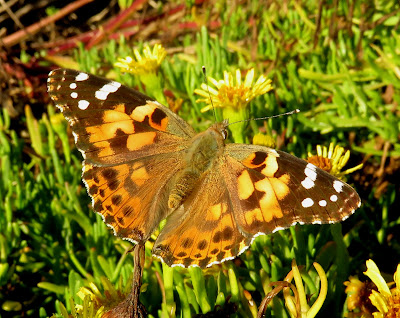Teal numbers have risen at the country park in recent days following the rain a week ago. The pools in the grazing fields have filled up with more water, providing more feeding opportunities for various wildfowl and waders. This colourful male teal above, was quite obliging as it swam along the park dyke.
On Saturday 26th around 100 teal were on the fields while 200 were present on Wednesday 23rd.
A common buzzard perched on a willow tree at the back of the fields on Saturday morning, two snipe were at the pools, 30+ shoveler were on the park pond. Towards the end of the afternoon two noisy kingfishers were heard calling at the park pond by Ian Black.
At the Point a sparrowhawk appeared to catch a dunnock from the bushes and while flying away with it, was forced to drop its prey by the mobbing crows. The pair of stonechats was still at the Point, then later seen along the clifftop. A rock pipit and 10 linnets were also at the Point.
In the river Colne 3 velvet scoter, 4 common scoter and a scaup were seen by Steve Entwistle on Saturday afternoon. The three velvet scoters were first seen in the Colne on Wednesday 23rd by Andy Field from the seawall near the Golfhouse. Also in the river that day were 8 common scoter and 4 red-breasted mergansers.
Numbers of wigeon have remained roughly 1500 birds in the grazing fields, also the four white-fronted geese have been present all week, as have 50 greylags and up to 400 brent geese at times too.On Saturday 26th around 100 teal were on the fields while 200 were present on Wednesday 23rd.
A common buzzard perched on a willow tree at the back of the fields on Saturday morning, two snipe were at the pools, 30+ shoveler were on the park pond. Towards the end of the afternoon two noisy kingfishers were heard calling at the park pond by Ian Black.
At the Point a sparrowhawk appeared to catch a dunnock from the bushes and while flying away with it, was forced to drop its prey by the mobbing crows. The pair of stonechats was still at the Point, then later seen along the clifftop. A rock pipit and 10 linnets were also at the Point.
In the river Colne 3 velvet scoter, 4 common scoter and a scaup were seen by Steve Entwistle on Saturday afternoon. The three velvet scoters were first seen in the Colne on Wednesday 23rd by Andy Field from the seawall near the Golfhouse. Also in the river that day were 8 common scoter and 4 red-breasted mergansers.
An early morning call on Friday 25th from Chris Balchin at Colne Point, alerted me to five common cranes heading towards East Mersea. A dash to the clifftop proved rewarding as the cranes were quickly picked up in flight over the sea as they flew lazily westwards towards Bradwell.
At the park pond on Friday a female pintail emerged from underneath the weeping willow and then flew off with all the other ducks on the pond after being spooked. Also present were 2 tufted duck, 4 gadwall, 25 shoveler, 20 mallard and 50 teal. Two redwings were by the pond on Thursday 24th.
Eight siskins were with 15 goldfinches in the alders by the park pond on Wednesday 23rd and 30 linnets in the fields.
A barn owl was reported by the East Mersea road near Fen Farm late on Friday afternoon.
As dawn broke on Wednesday at West Mersea, 1500+ starlings were seen flying leaving their night roost along the Avenues, heading to feed in the fields by Bocking Hall. Also 200 cormorants passed over West Mersea at dawn as they headed out to sea.
At least two foxes were on the prowl at the back of the fields on the sunny Saturday, making the grazing wigeon very nervous. A third fox was also trying to sleep at the back of the park pond.
By mid-morning one of these foxes was seen trotting round the side of the pond passing in front of the hide, where it was snapped above. Moorhens, wood pigeons and rabbits all dived for cover as the fox came trotting past.
By mid-morning one of these foxes was seen trotting round the side of the pond passing in front of the hide, where it was snapped above. Moorhens, wood pigeons and rabbits all dived for cover as the fox came trotting past.
The moth trap was put out at the park overnight on Tuesday 22nd resulting in four December moths, one pictured above, four feathered thorns, a large yellow underwing as well as a rusty dot pearl.























































